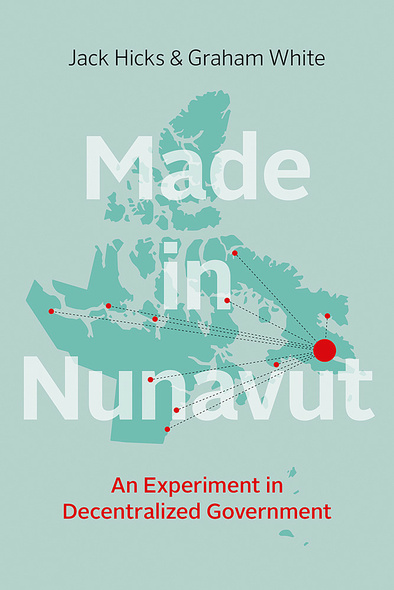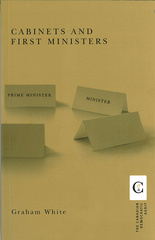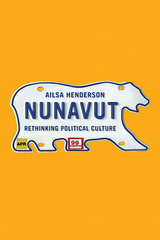Our shopping cart is currently down. To place an order, please contact our distributor, UTP Distribution, directly at utpbooks@utpress.utoronto.ca.

On April 1, 1999, after decades of dreams and negotiations and years of planning, the Inuit-dominated territory of Nunavut came into being in Canada’s Eastern and Central Arctic. This was a momentous occasion, signifying not only the first change to the map in over half a century but also a remarkable achievement in terms of creating a new government from the ground up.
Made in Nunavut provides the first behind-the-scenes account of how the Government of Nunavut (GN) came into being, exploring the many political and administrative issues that arose in its design and implementation. The book offers a close analysis of the period between the passage of the Nunavut Act in 1993 and the start-up of the GN in 1999, paying close attention to its most distinctive and innovative organizational design feature – the decentralization of offices and functions that would normally be located in the capital to small communities spread across the vast territory. It examines how this decentralization was implemented post-1999 and concludes by taking a hard look at whether the GN’s controversial structure has provided better government for the people of Nunavut.
The result of nearly two decades of research and writing by leading authorities on the politics of the Canadian Arctic, Made in Nunavut is a definitive guide to understanding the structure and politics of Canada’s youngest territory.
This book will be of interest to scholars, students, and public servants doing research and work in the areas of Canadian public administration, Indigenous governance, public policy, and territorial governance.
Awards
- 2016, Shortlisted - Donald Smiley Prize, Canadian Political Science Association
Made in Nunavut fills an important gap. Up to now little has been written about the process through which the new territory was formed, in the period from 1993 to 1999, and on the extent to which the hopes and aspirations for that territory have been realized in the years following its establishment. This is the subject matter of Made in Nunavut, with a particular focus on the decentralization of certain functions of the Nunavut government to various communities across the territory. It is a work well suited to students of political science, public administration, and northern studies, primarily at the university level, but for some at a college level as well: it provides an enormous information base. It is written in a non-technical manner, and in this sense is also suited to the general reader.
Made in Nunavut is meticulous and beautifully researched. It recounts an experiment in governance in the strangest place on earth, a territory of 1.9 million square kilometres flung across three time zones … Made in Nunavut is the definitive analysis of the nation’s most ambitious trial in home rule.
With stories and details gathered together for the first time, Made in Nunavut … provides a behind-the-scenes view, a critical evaluation and a solid historical account.
Scholars of the North have waited a long time for Made in Nunavut. Jack Hicks and Graham White chart the dream, attempt, debate, practice, and consequence of ‘decentralization’ – a technocratic term for the creation of a new form of sub-national government. This book will be a reference point for studies of Nunavut and of the modern Canadian parliamentary tradition for years to come.
This assiduously researched study concludes that administrative incompetence and weak political leadership, not decentralization, are to blame for Nunavut’s disappointing performance since the territory’s creation. Nunavut officials who choose to ignore this conclusion will do so at their peril.
An ambitious, masterful history. Made in Nunavut is essential reading for those interested in the North and the governance of other remote regions, as well as Indigenous governance. The scholarship is meticulous. The contribution is significant and original.
Jack Hicks is a social research consultant and a university and college lecturer. He has worked in a range of senior positions in Nunavut, and has written and presented widely about public policies across the circumpolar Arctic (especially Greenland and Nunavut). His primary research interests are the social determinants of mental health and suicide behaviour among Indigenous children and youth, the negotiation and implementation of Indigenous rights agreements, the political economy of the governments and other institutions arising from such agreements, and the comparative analysis of the political economy of non-renewable resource development across the circumpolar Arctic.
Graham White is a professor emeritus in the Department of Political Science at the University of Toronto. He has written widely on Canadian politics, mostly about governmental institutions such as legislatures and cabinets at the provincial/territorial level. He has been writing about the politics of the Canadian Arctic since the late 1980s. He is the author or editor of a dozen books, including Cycling into Saigon: The Conservative Transition in Ontario (co-authored with David R. Cameron) and Cabinets and First Ministers. He is a former president of the Canadian Political Science Association and is currently English co-editor of the Canadian Journal of Political Science.
Preface
1 Introduction
2 The Literature and Experience of Decentralization in Canada
3 The Land, the Claim, and the Act
4 The Players and Their Interactions
5 The Decentralization Initiative: January 1994–December 1995
6 Solidifying the Plan: January 1996–April 1997
7 Achieving the Impossible: April 1997–April 1, 1999
8 Additional Design and Implementation Issues
9 Implementing Decentralization
10 Decentralization Evaluated
11 Conclusion
Notes
Index










